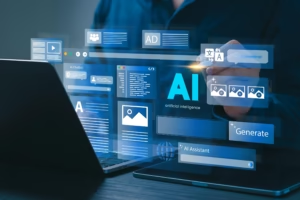AI isn’t just a thought from the future; it’s now a force that’s changing how businesses grow and come up with new ideas. In today’s fast-paced market, businesses that use AI well can gain a competitive edge by improving customer interaction, streamlining processes, and opening up new income streams. In 2025, these are the best AI business strategies that companies should use to grow and come up with new ideas.
Adding AI to the most important business tasks
One of the best ways to use AI to boost growth is to build it right into the way your business works. Leading companies don’t just use AI as a separate tool. Instead, they use AI to power automation and data in all of their areas, including sales, marketing, finance, and operations. This combination lets decisions be made in real time, cuts down on mistakes made by humans, and speeds up work processes.
AI can handle jobs that are done over and over again, like billing, data entry, and customer service, so workers can focus on more important tasks. AI-powered analytics systems can also find patterns and outliers in business data, which helps leaders make quick, well-informed strategic decisions.
Using AI to give each customer a more personalized experience
Customers have higher standards than ever, and custom is the only way to keep them coming back and increase sales. AI lets companies give customers highly customized experiences by looking at a lot of information about them, like their viewing past, purchases, and tastes, to make product suggestions, marketing messages, and contacts with customer service more relevant to each person.
Companies that use AI-driven personalization say their customers are happier and their sales rates have gone up. Natural language processing-powered chatbots and virtual helpers can give fast, personalized answers. This makes conversations smooth, which builds trust and interest in a brand.
Using predictive analytics to get ahead in the market
AI technique called predictive analytics is very good at predicting market trends, customer behavior, and business needs. Businesses can predict demand, make the best use of their supplies, and lower their risks by using machine learning models on both past and real-time data.
For example, stores use prediction analytics to figure out when holiday sales will go up and then change their stock to avoid having too much or too little of a product. AI is used by financial companies to spot scam trends and changes in the market early on, which protects assets and improves compliance.
With this kind of planning, businesses can change their plans ahead of time, make better use of their resources, and get an edge over their competitors.
Using AI to power product development to drive innovation
AI is changing the way businesses come up with new ideas and goods. AI can find holes and chances in the market by looking at what customers say, what competitors are selling, and new trends. This new information speeds up the process of research and development.
AI-powered simulation and modeling tools also allow for quick testing and development, which cuts down on time and cost to market. AI is even used by some companies to co-create with customers, making goods more fit each person’s wants in real time.
This flexible approach to innovation makes businesses more flexible and helps them stay ahead in industries with a lot of competition.
Using intelligent automation to improve operational efficiency
For growth to continue, operations must be run efficiently. By mixing AI skills like computer vision and natural language understanding with robotic process automation (RPA), intelligent automation makes complicated routines easier to use.
This lets companies handle whole processes, like handling insurance claims, making sure banks follow the rules, and checking the quality of goods made in factories. Intelligent automation not only cuts down on mistakes and speeds up work, but it also lets things keep getting better by letting AI learn from past mistakes. Companies can use the money they save to come up with new ideas and grow by cutting costs and making things more accurate.
Putting in place decision support systems that are driven by AI
Making decisions based on data is the key to success in business today. AI-powered decision support systems turn huge amounts of data into insights that can be used, which helps leaders make choices more quickly and wisely.
Machine learning, natural language processing, and data visualization are some of the methods that these systems use to find relevant information, predict what might happen, and suggest the best course of action. For instance, supply chain managers can guess when problems will happen and move packages, and marketers can figure out how much to spend on campaigns based on how well they’re doing in real time.
AI-powered decision support turns huge amounts of complex data into clear information, giving leaders the trust they need to drive growth.
Making AI innovation a way of life
AI business plans need more than just technology to work. They also need a culture that encourages new ideas, experiments, and constant learning. Companies should spend money to teach their workers about AI tools and ideas, and they should encourage people from different departments to work together to find new AI possibilities.
Leaders need to encourage taking risks and using fast methods that let teams quickly build prototypes and make changes to AI solutions. This mindset not only speeds up the use of AI, but it also lets people come up with new ways to use it that create unique business value.
As technology changes and new problems come up, companies that have a strong AI mindset are better able to react.
Creating AI practices that are moral and responsible
As the use of AI grows, it is important to keep social concerns in mind to keep customers trusting and following the rules. It is very important to have AI models that are clear, protect data privacy, and show how decisions are made.
Adding ethics to AI strategy means creating rules for how AI systems should be run, checking them for fairness on a regular basis, and making sure humans are in charge when they need to be. Responsible AI builds trust with partners and customers, which lowers the risk of legal problems or damage to image.
Taking an active role in AI ethics promotes long-term growth and makes sure that AI innovations are in line with social ideals.
Working together with partners in AI technology
Not many businesses can build all of their own AI powers. Working together with AI technology companies, businesses, and academic institutions can make it faster to get access to the newest tools and knowledge.
Businesses can test out new AI solutions, make tools fit their needs, and quickly expand on projects that work well when they work together. Sharing information is easier in open innovation platforms, and it takes less time for AI-powered goods and services to reach the market.
Strategic cooperation is a smart way to use new ideas from outside sources while keeping internal resources focused on what they do best.
Checking the Effects of AI and Always Improving It
Companies must set clear KPIs and keep an eye on AI success all the time to make sure that their AI plans lead to real growth. AI’s value can be measured by things like cost saves, increased income, customer happiness, and operating speed.
Teams can find ways to improve AI results, make models better, and change tactics as needed by regularly analyzing AI results. Continuous improvement makes sure that investments in AI stay in line with changing market conditions and business goals.
AI goes from being a one-time project to a long-term economic edge when it is evaluated based on data.
In conclusion
In 2025, AI business plans are a strong way to drive growth and new ideas. Companies can find new possibilities and work more efficiently by using AI in their core processes, making customer interactions more personalized, using predictive analytics, and encouraging a culture of innovation. Responsible use and smart relationships make AI’s effects even bigger.
If businesses use these AI tactics now, they will not only do well in the current market, but they will also be ready to lead in the future of work and digital change.




